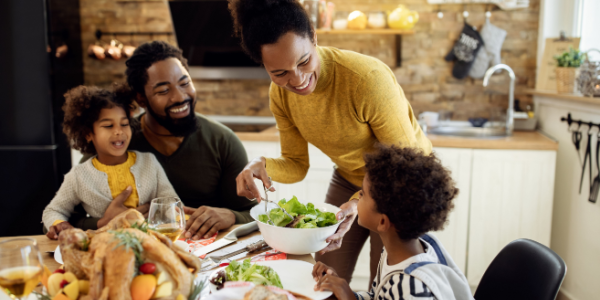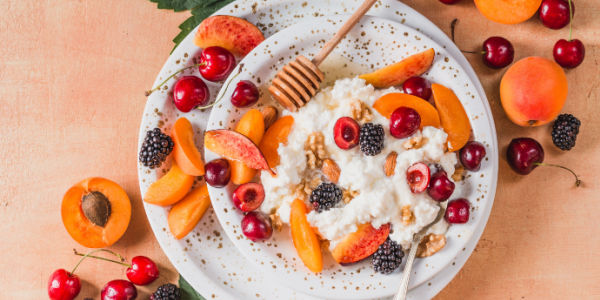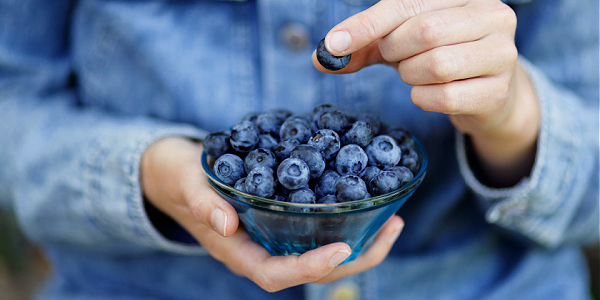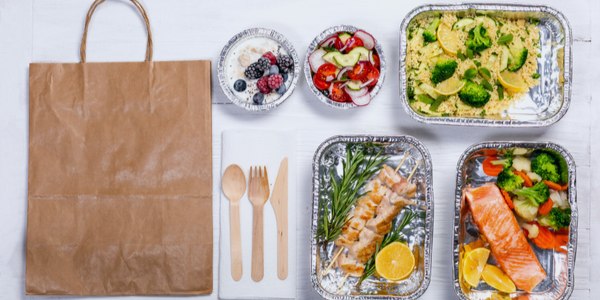
Wondering how to eat healthy on Thanksgiving? While some people enjoy that “stuffed” feeling, others dread the sensation of overeating and that they’ve spoiled the rest of the afternoon.
Especially if your holiday is busy with travel or multiple events, it’s smart to have a handful of healthy thanksgiving tips in mind. From pre-meal preparation to incorporating physical activity, there are plenty of tactics for making Thanksgiving more manageable.
Read on for Thanksgiving tips to stay healthy, including ideas for staying in shape physically, mentally, and emotionally during the holiday’s events.
Importance of Healthy Thanksgiving Tips
The holidays introduce a plethora of potential roadblocks when it comes to health goals. From judgy relatives to routines thrown out of whack, it’s natural to feel a bit of resistance during the holidays. Fortunately, there are plenty of ways to stay grounded in your wellness, whether you’re pursuing weight loss or simply trying to stay mindful.
In fact, staying healthy can enhance your holiday enjoyment! Avoiding excess eating and maintaining physical activity can prevent sluggishness and ensure you can fully partake in traditions.
Here’s how to foster gratitude for your mind and body during Thanksgiving week—and throughout the year!
Plan Ahead
One vital aspect of a healthy holiday is planning ahead. A small amount of preparation can make a big difference in how you feel during the week of Thanksgiving.
Offer to Bring Your Own Dishes
If you’re unsure about what’s being offered at the feast, offer to bring your own dishes. It’s also always a good idea to bring enough to share, and this may help ease the concerns of your host.
For utmost respect, ask the host ahead of time if they mind you bring a dish that aligns with your health goals or values. They’ll likely be onboard, and inspired by your commitment!
Prepare Personal Boundaries
Despite the efforts of pushy relatives or friends, it may not be sensible or physically possible for you to eat a little bit of everything, or there may be some foods that you simply don’t enjoy. So while it may initially sound silly, an important skill to help you healthily navigate events is by preparing to say “no.”
But for relatives who may view rejecting food as insensitive, you can always ask for a to-go box. This practice can help you truly enjoy these foods at a later point or may simply let you dispose of foods you’re not interested in the privacy of your own home.
Enjoy Exercise
Planning fun ways to stay physically active can help make meaningful movement during the holidays come to fruition. And while regular gym sessions may be hard to find on the holidays, activities can be enjoyed with family, friends, or houseguests who are visiting.
Try planning one fun activity (at least 30 minutes) for each of the days leading up to Thursday’s big dinner, and invite interested family members or like-minded, fitness-focused friends to join. Ride the movement momentum with some Black Friday shopping—not online, of course!
Eat Breakfast
Breakfast can help kickstart your body in the morning, and skipping it can cause intense hunger cravings later in the day. While you might think that eating less earlier in the day to save calories for later is a good idea, skipping meals can lead to overindulgence at Thanksgiving dinner, resulting in physical discomfort and potential feelings of guilt or shame.
Instead of skipping breakfast (and other balanced meals and snacks), try sticking to your routine and priortize lean protein, fiber, and healthy fats. This will help keep hunger at bay while still leaving plenty of room for your favorite foods.
Stay Hydrated
Between cooking copious amounts of food in the kitchen and participating in family fun and activities, you may actually be more active on Thanksgiving day than a normal day. For this reason, it’s essential to hydrate, especially since water and fluids in the body can help make for a more pleasant digestive experience after all that food.
Don’t forget to drink enough water during the day and between meals, especially if it includes athletic events—like family football games—or travel. To sneak some electrolytes and hydrating fluids into your meal, you can cook with bone broth.
As a host, you can also encourage guests to hydrate by regularly setting out plenty of hydrating options, such as water, sparkling water, or 100% juice. For cold climates, healthy hot chocolate can also count as a hydrating (and delicious!) liquid.
Make Simple & Healthy Swaps
Although notorious for being full of fat, salt, and sugar, holiday meals can be created healthily. A few simple swaps can make the Thanksgiving meal more heart-healthy and better aligned with other healthy eating patterns, too.
For example, instead of serving mashed potatoes, which can be rich in carbs and saturated fats, try mashed cauliflower, a half potato and half cauliflower blend, or cinnamon-spiced sweet potatoes. Preparing roasted turkey over fried is another excellent swap to keep you fueled and satisfied.
Nearly every food has a “healthy” version, so the possibilities are endless!
Practice Portion Control
Having a healthy holiday doesn’t mean you have to avoid seasonal favorites. However, you can enjoy foods you love—or only get to enjoy once a year—in a thoughtful, intentional way. Portion control can help you stay in tune with your body’s needs
Build a Balanced Plate
Although it may be tempting to abandon proper plating just because it’s a holiday, it’s important to abide by portion size guidelines when possible. Myplate can be a good guide, although your personal health providers may suggest slightly more protein or veggies than grains.
Dishing out average serving sizes (or even smaller than normal serving sizes) can ensure you get a little taste of everything. This can help you to enjoy the whole meal instead of filling up on one food.
Focus on Filling Food Components
Both before and during the main meal, focus on filling nutrients—namely, protein, healthy fats, and fiber. Unlike carbohydrates, which are utilized relatively quickly by the body, these nutrients are digested more slowly and can help promote a feeling of fullness.
Start Small
Thanksgiving is a unique meal with many more side dishes than usual to choose from. Since there will be many foods to try, start with small portions and know you can always go back for more.
This tactic can help you make the most of both dinner and dessert. For example, try a thinner slice of pumpkin pie, and don’t overdo it on the whipped cream. A small dollop will likely be enough, whereas more than a couple tablespoons adds a significant amount of calories.
Keep Food In The Kitchen
Another simple yet effective tactic is to keep food in the kitchen. Naturally placing foods further from the table, instead of at the table, will allow you and your guests to truly evaluate whether you want more food before dishing up seconds.
Plus, less food on the table may make it easier to see guests across from you. And if you’re feeling fancy, a more open table allows more room for decorative centerpieces!
Eat More Mindfully
Thanksgiving may not seem like the most obvious time to practice mindful eating, but it’s a great time to tune into gratitude and practice intentional eating patterns. The following tips can help connect your mind to your body during the eating process.
Tune Into Body Cues
One of the basic tenets of intuitive or mindful eating is to tune into body cues, such as hunger and fullness. Listening to the signals your body sends you, instead of ignoring them, can ultimately make you more comfortable physically post-meal and help you to avoid a mental struggle of shame or guilt.
If you aren’t practiced in this eating pattern, that’s okay! A simple check-in you can do with yourself about 20 minutes into your meal is to ask, “Am I full?”
Since there will likely be leftovers, you don’t have to operate in a scarcity mindset. Eat enough to make the meal enjoyable, knowing that you’ll probably be able to take what you didn’t get a chance to eat during dinner home to enjoy the next day. (Hello, Thanksgiving leftovers!)
Pause Between Bites
Confused by your body’s cues? If you put your fork down between bites, it will allow some time for food to settle in and give your body a moment to catch up. It’s also a natural way to encourage eating more slowly.
Additionally, pausing between bites allows for conversation, which is often a natural part of Thanksgiving festivities.
Practice Gratitude
Eager to introduce gratitude into your eating pattern? Thanksgiving is the perfect time to do so! And by being able to eat slowly, you can engage in the holiday in a more meaningful way.
One easy practice to stay focused on gratitude is simply being grateful for each bite and your body’s ability to digest it. Often, when you think of one thing you’re grateful for, it’s easy to think of another.. And then another… And then another. You get that idea!
Savor Flavors
Another mindful eating tip that may sound too good to be true is to savor each bite. Some Thanksgiving foods you will only get once a year, so tuning into the sensations of each taste can allow you to fully enjoy these rare eats and treats.
Truly relish the opportunity to experience the taste, texture, and mouthfeel of these foods. Turkey, cranberry sauce, and pecan pumpkin pie, oh my!
Be Mindful About Food Order
Especially for foodies hoping for tighter blood sugar control, it helps to be mindful of food order. Eating proteins or vegetables first, as opposed to beginning with a carbohydrate-heavy option like a dinner roll, may ultimately make blood sugar more stable.
So, although it may not necessarily be considered “traditional,” it may make more sense to switch around your side dishes.
Focus On Time With Loved Ones
One of the easiest ways to enjoy the holiday is to simply focus on making memories. Cherish time with family and friends instead of hyper-focusing on food. While this may sound easier said than done, practice truly does make progress.
Like seasonal foods, Thanksgiving guests may be people you only see once a year! Making people the focus of the afternoon or evening, instead of the food, can help you to create lasting memories.
Final Thoughts on Thanksgiving Tips to Stay Healthy
Since Thanksgiving is a food-focused holiday, it’s an important time to focus on health. In addition to eating in a balanced and mindful way, incorporating hydrating fluids and physical activities into the week can ensure you stay fueled.
Remember to truly savor your favorite flavors, as well as treasured time with family and friends.







